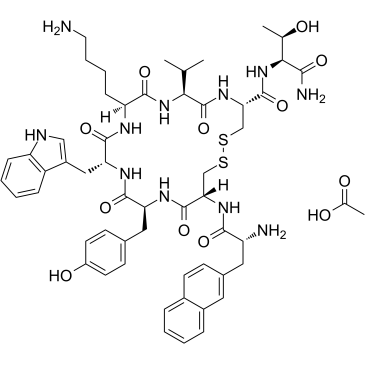Lanreotide acetate
Modify Date: 2024-01-06 19:08:41

Lanreotide acetate structure
|
Common Name | Lanreotide acetate | ||
|---|---|---|---|---|
| CAS Number | 2378114-72-6 | Molecular Weight | 1156.38 | |
| Density | N/A | Boiling Point | N/A | |
| Molecular Formula | C56H73N11O12S2 | Melting Point | N/A | |
| MSDS | N/A | Flash Point | N/A | |
Use of Lanreotide acetateLanreotide acetate (BIM 23014 acetate) is a somatostatin analogue with antineoplastic activity. Lanreotide acetate can be used for carcinoid syndrome[1][2]. |
| Name | Lanreotide acetate |
|---|
| Description | Lanreotide acetate (BIM 23014 acetate) is a somatostatin analogue with antineoplastic activity. Lanreotide acetate can be used for carcinoid syndrome[1][2]. |
|---|---|
| Related Catalog | |
| In Vitro | Lanreotide acetate (BIM 23014 acetate) (24-48 hours; 100 nM; GH3 cells) combines with radiation increasing in apoptotic sub-G1 proportion[1]. Lanreotide acetate results in a dose-dependent decrease in GH3 cell colony forming units. Lanreotide acetate at doses of 1, 10, 100, and 1000 nM results in cell survival rates of 75, 56, 39 and 27% respectively. The IC50 (50% inhibition of cell growth) was 57 nM[1]. Lanreotide acetate inhibits GH-secreting pituitary adenoma cell proliferation and hormone release in vitro[2]. |
| In Vivo | Lanreotide acetate (2.5-10mg/kg; s.c.; daily for 5 days) resluts in tumor growth inhibition[1]. Animal Model: Male nude mice, 8 weeks old and 20–25 g in body weight (GH3 tumor-bearing nude mice)[1] Dosage: 2.5, 5, 10 mg/kg Administration: Subcutaneous; daily for 5 days Result: Produced tumor growth inhibition. |
| References |
| Molecular Formula | C56H73N11O12S2 |
|---|---|
| Molecular Weight | 1156.38 |